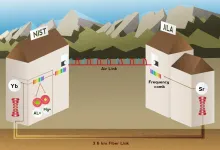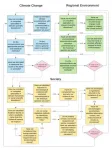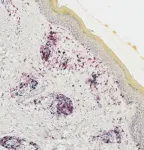(Press-News.org) Researchers find that the earliest bacteria had the tools to perform a crucial step in photosynthesis, changing how we think life evolved on Earth.
The finding also challenges expectations for how life might have evolved on other planets. The evolution of photosynthesis that produces oxygen is thought to be the key factor in the eventual emergence of complex life. This was thought to take several billion years to evolve, but if in fact the earliest life could do it, then other planets may have evolved complex life much earlier than previously thought.
The research team, led by scientists from Imperial College London, traced the evolution of key proteins needed for photosynthesis back to possibly the origin of bacterial life on Earth. Their results are published and freely accessible in BBA - Bioenergetics.
Lead researcher Dr Tanai Cardona, from the Department of Life Sciences at Imperial, said: "We had previously shown that the biological system for performing oxygen-production, known as Photosystem II, was extremely old, but until now we hadn't been able to place it on the timeline of life's history. Now, we know that Photosystem II show patterns of evolution that are usually only attributed to the oldest known enzymes, which were crucial for life itself to evolve."
Photosynthesis, which converts sunlight into energy, can come in two forms: one that produces oxygen, and one that doesn't. The oxygen-producing form is usually assumed to have evolved later, particularly with the emergence of cyanobacteria, or blue-green algae, around 2.5 billion years ago.
While some research has suggested pockets of oxygen-producing (oxygenic) photosynthesis may have been around before this, it was still considered to be an innovation that took at least a couple of billion years to evolve on Earth.
The new research finds that enzymes capable of performing the key process in oxygenic photosynthesis - splitting water into hydrogen and oxygen - could actually have been present in some of the earliest bacteria. The earliest evidence for life on Earth is over 3.4 billion years old and some studies have suggested that the earliest life could well be older than 4.0 billion years old.
Like the evolution of the eye, the first version of oxygenic photosynthesis may have been very simple and inefficient; as the earliest eyes sensed only light, the earliest photosynthesis may have been very inefficient and slow.
On Earth, it took more than a billion years for bacteria to perfect the process leading to the evolution of cyanobacteria, and two billion years more for animals and plants to conquer the land. However, that oxygen production was present at all so early on means in other environments, such as on other planets, the transition to complex life could have taken much less time.
The team made their discovery by tracing the 'molecular clock' of key photosynthesis proteins responsible for splitting water. This method estimates the rate of evolution of proteins by looking at the time between known evolutionary moments, such as the emergence of different groups of cyanobacteria or land plants, which carry a version of these proteins today. The calculated rate of evolution is then extended back in time, to see when the proteins first evolved.
They compared the evolution rate of these photosynthesis proteins to that of other key proteins in the evolution of life, including those that form energy storage molecules in the body and those that translate DNA sequences into RNA, which is thought to have originated before the ancestor of all cellular life on Earth. They also compared the rate to events known to have occurred more recently, when life was already varied and cyanobacteria had appeared.
The photosynthesis proteins showed nearly identical patterns of evolution to the oldest enzymes, stretching far back in time, suggesting they evolved in a similar way.
First author of the study Thomas Oliver, from the Department of Life Sciences at Imperial, said: "We have used a technique called Ancestral Sequence Reconstruction to predict the protein sequences of ancestral photosynthetic proteins. These sequences give us information on how the ancestral Photosystem II would have worked and we were able to show that many of the key components required for oxygen evolution in Photosystem II can be traced to the earliest stages in the evolution of the enzyme."
Knowing how these key photosynthesis proteins evolve is not only relevant for the search for life on other planets, but could also help researchers find strategies to use photosynthesis in new ways through synthetic biology.
Dr Cardona, who is leading such a project as part of his UKRI Future Leaders Fellowship, said: "Now we have a good sense of how photosynthesis proteins evolve, adapting to a changing world, we can use 'directed evolution' to learn how to change them to produce new kinds of chemistry. We could develop photosystems that could carry out complex new green and sustainable chemical reactions entirely powered by light."
INFORMATION:
Beams of accelerated electrons power electron microscopes, X-ray lasers, medical accelerators and other devices. To optimize the performance of these applications, operators must be able to analyze the quality of the beams and adjust them as needed.
For the past few years, researchers at the Department of Energy's SLAC National Accelerator Laboratory have been developing "virtual diagnostics" that use machine learning to obtain crucial information about beam quality in an efficient, non-invasive way. Now, a new virtual diagnostic approach, published in Scientific Reports, incorporates additional information about the beam that allows the method to work in situations where conventional ...
Despite aquaculture's potential to feed a growing world population while relieving pressure on badly depleted oceans, the industry has been plagued by questions about its environmental impacts. (Watch related video: https://www.youtube.com/watch?v=DG_nl7-naYo)
But over the years, the diverse industry - which ranges from massive open-ocean salmon cages to family farm freshwater tilapia ponds - has made significant strides toward sustainability, according to a new Stanford-led analysis.
The study notes, however, that in order for the global aquaculture sector to deliver on its full promise, more effective oversight measures are ...
In a significant advance toward the future redefinition of the international unit of time, the second, a research team led by the National Institute of Standards and Technology (NIST) has compared three of the world's leading atomic clocks with record accuracy over both air and optical fiber links.
Described in the March 25 issue of Nature, the NIST-led work is the first to compare three clocks, based on different atoms, and the first to link the most advanced atomic clocks in different locations over the air. These atomic clock comparisons place the scientific community one step closer to meeting the guidelines for redefinition of the second.
"These comparisons are really defining ...
Carbon dioxide in the atmosphere fuels plant growth. As carbon levels rise, it's appealing to think of supercharged plant growth and massive tree-planting campaigns drawing down the CO2 produced by fossil fuel burning, agriculture and other human activities.
New research published March 24 in Nature, however, suggests that when elevated carbon dioxide levels drive increased plant growth, it takes a surprisingly steep toll on another big carbon sink: the soil.
One likely explanation, the authors say, is that plants effectively mine the soil for nutrients they need to keep up with carbon-fueled growth. Extracting the extra nutrients requires revving up microbial activity, which then releases CO2 into the atmosphere that might otherwise remain locked in soil.
The findings contradict ...
The secret to building superconducting quantum computers with massive processing power may be an ordinary telecommunications technology - optical fiber.
Physicists at the National Institute of Standards and Technology (NIST) have measured and controlled a superconducting quantum bit (qubit) using light-conducting fiber instead of metal electrical wires, paving the way to packing a million qubits into a quantum computer rather than just a few thousand. The demonstration is described in the March 25 issue of Nature.
Superconducting circuits are a leading technology for making quantum computers because they are reliable and easily mass produced. But these circuits must operate at cryogenic temperatures, and schemes for wiring them to room-temperature electronics are complex and prone to ...
As the signs of today's human-caused climate change become ever more alarming, research into the ways past societies responded to natural climate changes is growing increasingly urgent. Scholars have often argued that climatic changes plunge communities into crisis and provide the conditions that lead societies to collapse, but a growing body of research shows that the impacts of climate change on past populations are rarely so straightforward.
In a new paper published in Nature, scholars in archaeology, geography, history and paleoclimatology present a framework for research into what they term 'the History of Climate and Society' (HCS). The framework uses a series of ...
LEBANON, NH - Some melanoma patients respond very well to immunotherapy, experiencing profound and durable tumor regression. A fraction of these patients will also develop autoimmunity against their normal melanocytes--the cells that give rise to melanoma--a phenomenon called vitiligo. Melanoma survivors with vitiligo have long been recognized as a special group with an outstanding prognosis, and a strong response of immune system cells called T cells.
Immunotherapy researchers at Dartmouth's and Dartmouth-Hitchcock's Norris Cotton Cancer Center (NCCC) led by Mary Jo Turk, PhD, and surgical oncologist Christina Angeles, MD (now of University of Michigan), have discovered how a subset ...
The ocean is dynamic in nature, playing a crucial role as a planetary thermostat that buffer global warming. However, in response to climate change, the ocean has generally become stabler over the past 50 years. Six times stabler, in fact, than previously estimated--as shown by a new study that researchers from the CNRS, Sorbonne University, and IFREMER have conducted within the scope of an international collaboration.* Warming waters, melting glaciers, and disrupted precipitation patterns have created an ocean surface layer cut off from the depths. Just as oil and ...
Training babies' brains and bodies might delay the onset of Rett syndrome, a devastating neurological disorder that affects about 1 in 10,000 girls worldwide.
In experiments with mice that replicate the genetic disorder, scientists discovered that intense behavioral training before symptoms develop staves off both memory loss and motor control decline. Compared to untrained mice, those trained early in life were up to five times better at performing tasks that tested their coordination or their ability to learn, Howard Hughes Medical Institute Investigator Huda Zoghbi and her colleagues report March 24, 2021, in the journal Nature.
Those data, from animals whose symptoms closely mimic the human disease, offers a clear rationale for genetically screening newborns for Rett syndrome, ...
New York, NY (March 24, 2021) -- Immunotherapy is not only significantly less effective in liver cancer patients who previously had a liver disease called non-alcoholic steatohepatitis (NASH), but actually appears to fuel tumor growth, according to a Mount Sinai study published in Nature in March. NASH affects as many as 40 million people worldwide and is associated with obesity and diabetes.
The researchers led a large international collaboration to investigate immunotherapy's effect on hepatocellular carcinoma (HCC), a deadly liver cancer, caused by NASH. They conducted a meta-analysis ...





